Students can practice TS 10th Class Maths Solutions Chapter 3 Polynomials Ex 3.2 to get the best methods of solving problems.
TS 10th Class Maths Solutions Chapter 3 Polynomials Exercise 3.2
Question 1.
The graphs of y = p(x) are given in the figure below, for some polynomials p(x). In each case, find the number of zeroes
of p(x).
Solution:
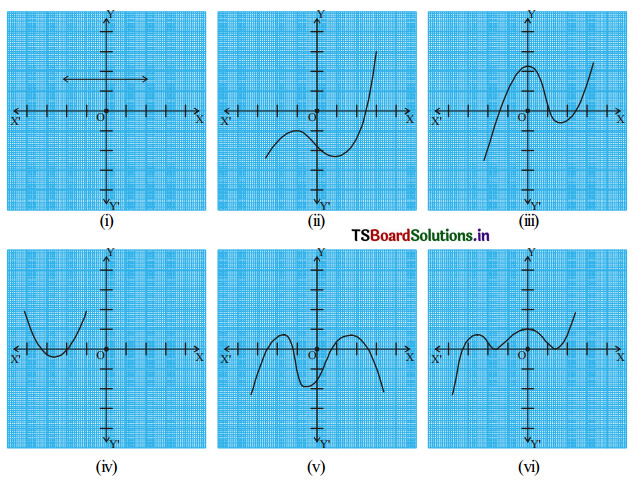
Solution:
Six figures are given and they are numbered.
In the first figure, there are no zeroes.
In the second figure, there is one zero.
In the third figure, there are three zeroes.
In the fourth figure, there are two zeroes.
In the fifth figure, there are four zeroes.
In the sixth figure, there are three zeroes.
Question 2.
Find the zeroes of the given polynomials.
(i) p(x) = 3x
(ii) p(x) = x2 + 5x + 6
(iii) p(x) = (x + 2) (x + 3)
(iv) p(x) = x4 – 16
Solution:
i) p(x) = 3x
p(0) = 3 × 0 = 0
∴ The zero of p(x) = 3x is 0
ii) p(x) = x2 + 5x + 6
= x2 + 3x + 2x + 6
= x(x + 3) + 2(x + 3) = (x + 2) (x + 3)
To find zeroes, let p(x) = 0
⇒ (x + 2) (x + 3) = 0
So, x + 2 = 0 (or) x + 3 = 0
⇒ x = -2 (or) x = -3
Therefore, the zeroes of x + 5x + 6 are – 2 and -3.
iii) p(x) = (x + 2) (x + 3)
⇒ x2 + 2x + 3x + 6
⇒ x2 + 5x + 6
To find zeroes, let p(x) = 0
⇒ (x + 2) (x + 3) = 0
So, x + 2 = 0 (or) x + 3 = 0
⇒ x = -2 (or) x = -3
∴ The zeroes of (x + 2) (x + 3) are -2 and -3.
iv) p(x) = x4 – 16
= (x2)2 – (4)2 = (x2 + 4) (x2 – 4)
= (x2 + 4)(x + 2)(x – 2)
To find zeroes, let p(x) = O
⇒ (x2 + 4) (x + 2)(x – 2) = 0
(i.e.,) x2 + 4 = 0 (or) x + 2 = 0 (or) x – 2 = 0
If x2 + 4 = 0, then x2 = -4 ⇒
x = ± \(\sqrt{-4}\)
If x + 2 = 0, then x = -2
If x – 2 = 0, then x = 2
∴ The zeroes of the polynomial x4 – 16 are -2, 2 and ± \(\sqrt{-4}\).
![]()
Question 3.
Draw the graphs of the given polynomials and find the zeroes. Justify the answers. (A.P.June’ 15)
(i) p(x) = x2 – x – 12
(ii) p(x) = x2 – 6x + 9
(iii) p(x) = x2 – 4x + 5
(iv) p(x) = x2 + 3x – 4
(v) p(x) = x2 – 1
Solution:
i) p(x) = x2 – x – 12

∴ The zeros of x2 – x – 12 are 4 and -3.
Scale:
On X-axis: 1 cm = 1 unit
OnY-axis: 1 cm = 2 units
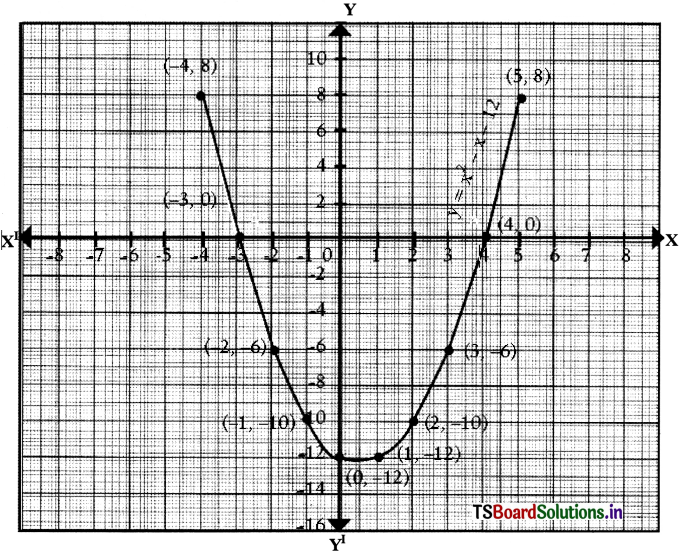
The graph intersects the X-axis at (4, 0) and (-3, 0)
ii) p(x) = x2 – 6x + 9

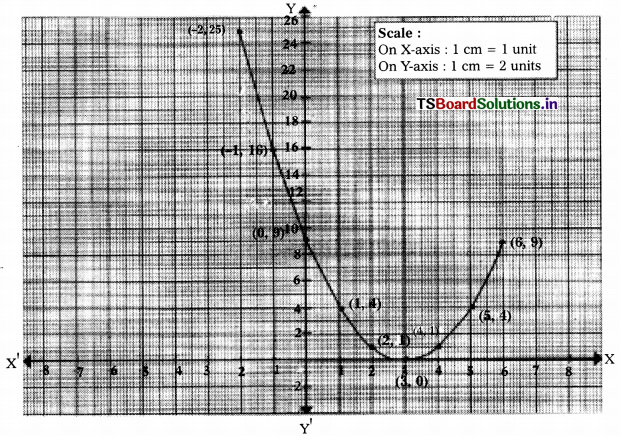
The graph intersects one the X-axis at only point (3, 0)
iii) p(x) = x2 – 4x + 5

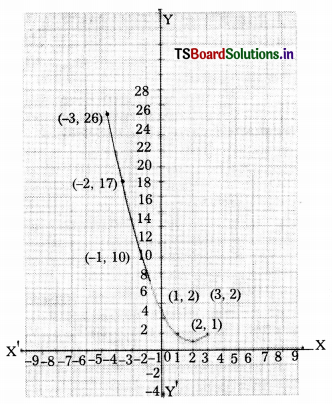
Scale:
On X-axis: 1 cm = 1 unit
OnY-axis: 1 cm = 2 units
The graph does not intersect at the X-axis.
There are no zeroes of the polynomial x2 – 4x + 5
![]()
iv) p(x) = x2 + 3x – 4

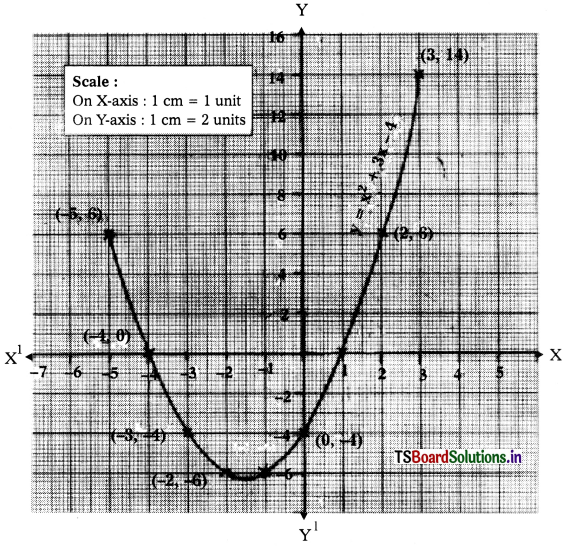
∴ The graph intersects the X-axis at (1, 0) and (-4, 0)
∴ The zeroes of the polynomial x2 + 3x – 4 are 1 and -4.
v) p(x) = x2 – 1

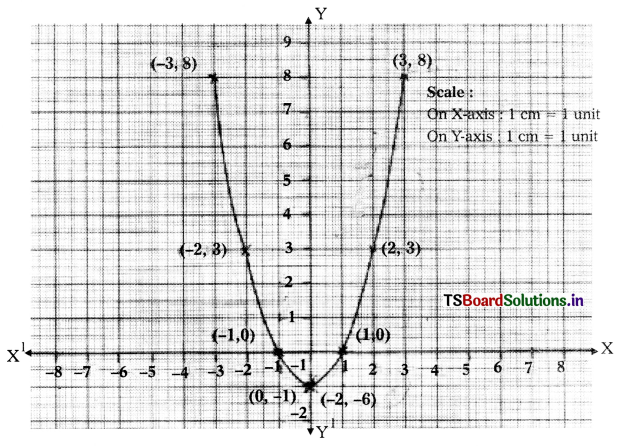
The graph intersects the X-axis at (-1, 0) and (1, 0)
∴ The zeroes of the polynomial x2 – 1 are -1 and 1.
Question 4.
Why are \(\frac{1}{4}\) and -1 zeroes of the polynomial p(x) = 4x2 + 3x – 1?
Solution:
p(x) = 4x2 + 3x – 1
∴ p(\(\frac{1}{4}\)) = 4(\(\frac{1}{4}\))2 + 3(\(\frac{1}{4}\)) – 1
= \(\frac{1}{4}\) + \(\frac{3}{4}\) + \(\frac{1}{1}\)
= \(\frac{1+3-4}{4}\) = \(\frac{0}{4}\) = 0
∴ p(-1) = 4(-1)2 + 3(-1) – 1
= 4(1) – 3 – 1
= 4 – 3 – 1
= 4 – 4 = 0
Since p(\(\frac{1}{4}\)) and p(-1) are equal to zero.
\(\frac{1}{4}\) and -1 are the zeroes of the polynomial.